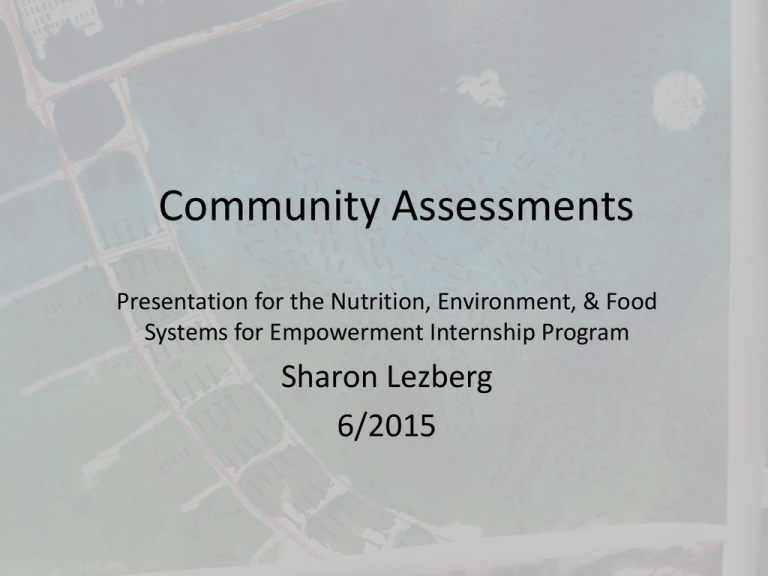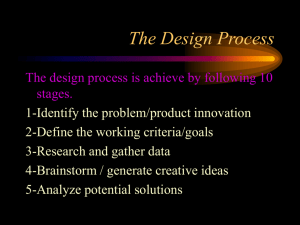Community Assessment Presentation_6_2015
advertisement

Community Assessments Presentation for the Nutrition, Environment, & Food Systems for Empowerment Internship Program Sharon Lezberg 6/2015 Presenter Information Sharon Lezberg Community Resource Development Educator, Dane County-UW Extension My involvement in NEFSE • Mentor, along with Joe Hankey, for the Brentwood Gardens for Empowerment Project What is a community assessment? - Identification of assets, needs, and community characteristics - A tool used to understand issues within a community Where are we now? Where do we want to be in the future? How do we get to the future we desire? Other Terms Utilized Needs Assessment What is a Situational Analysis? A systematic method for: • Collecting • Analyzing • Delivering Information About Community •Past Trends •Current Conditions Issues Problems Opportunities Challenges A Word About Assets and Needs • Assets are those resources that exist within a community and can be used to help meet community needs. • Community needs are “the gap between what a situation is and what it should be” (University of Kansas Work Group for Community Health and Development) Building Community Capacity • “Community’s ability to define and solve their own problems” (D. Easterling, The Colorado Trust) • Ability to provide “local solutions to local problems” (R. Atkinson & P. Willis, University of Tasmania) Why do Community Assessment? To gain an understanding of the community, including demographics, natural resource base, infrastructure, and systems (health, economic, etc.) In order to serve a community, you need to understand it Used to identify assets and needs Essential in planning: understand the past, evaluate the present, prepare for the future To test assumptions and relevance of activities, projects What are the underlying issues? - Use questions and research to get below the surface - In community work, it takes time to build trust - Accept that individuals within a community will have different interpretations of a situation Steps in a Community Assessment • Define the Purpose & Scope • Identify Collaborators • Collect Data – Gather existing data – Identify data gaps – Collect & analyze required information • Determine Key Findings • Set Priorities and Create an Action Plan Define Purpose and Scope • Identify community issue to be assessed, the impacted community members, and the geographic area to access • Determine key questions that you want answered • Be sure that your questions are related to the purpose of the assessment Identify Collaborators • Community members should be engaged in planning and implementation • Collaboration with other partners (corporations, nonprofit organizations, local community organizations) will increase access to data and to resources • Establishes relationships that will be important for implementation and action Collect Data • Collect Data – Gather existing data – Identify data gaps – Collect & analyze required information – Present the information to community partners – Analyze the information, with community partners Data Sources • Secondary Data: demographic data from Census, American Community Survey, other sources. In Wisconsin, the Applied Population Laboratory is a great source of data. • Secondary data may be for geographic areas that are larger in scope than your project area, and the data – if aggregated data – may mask disparities across populations. Gather your own Assessment Data – – – – – – Surveys Asset Mapping Informal Dialogue Key Informant Interviews Focus Groups SWOT analysis (Strengths, Weaknesses, Opportunities, Threats) – Network Analysis – Ethnography How do you Gather data from people who are marginalized, vulnerable, or hard to reach? • Participatory techniques – Participatory appraisal: needs matrix, community asset mapping, social resource mapping – Photo voice – Community dialogues & visioning • Personal observation Community Mapping Photo Voice Determine Key Findings Purposes of key findings: - They validate anecdotal evidence of community needs and assets. - They highlight significant trends found in the data collection process. - They reveal differences across segments of the community - They help clarify answers to the community assessment’s key questions. Set Priorities and Create an Action Plan • Setting priorities through community process • Action/implementation Planning: – Key finding (issue) – Activity or response – Deadline – Person responsible – Indicators of success



